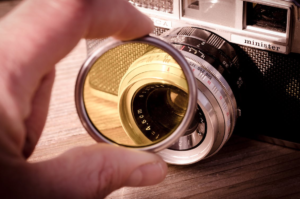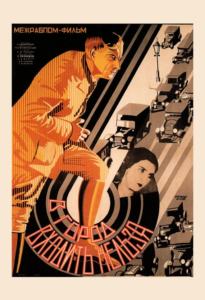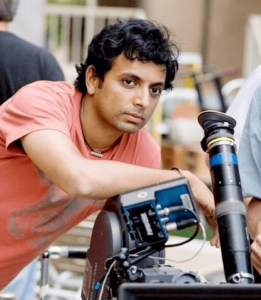A piece that can fit on top of your lens is known as a lens protector. In short, they’re nothing more than an additional protective layer placed on top of your regular lens feature. They are
- UV filters
- Lens hood
- Lens cap
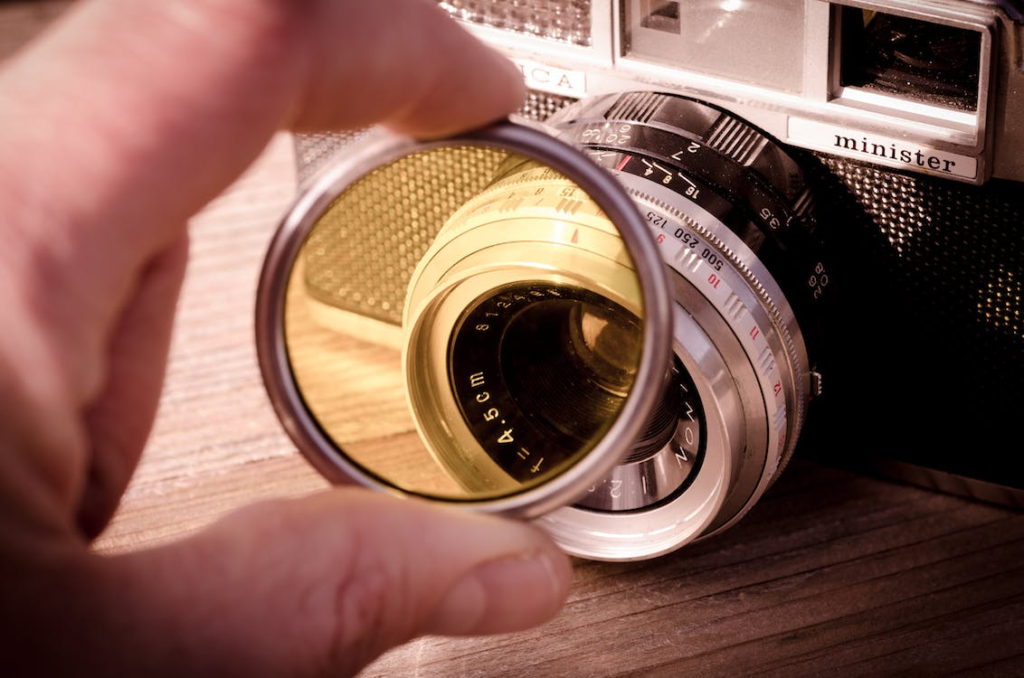
A lens protector may also be referred to as a filter since they are often used in combination. Most photographers use UV filters, which are the most prevalent kind of lens protector/filter. You may obtain numerous benefits from using a lens protector. The most important aspect of the protector is that it reduces lens damage. Just screw on a project, and you don’t have to worry about damaging your lenses. Investing in an expensive lens protector will safeguard your lens against sand, grit, moisture, and a variety of other concerns.
Importance of using lens protectors
Lens Protectors preserve your lens glass from tiny, abrasive particles by using protective filters. Protective filters come in various forms, from simple pieces of glass that shield your camera from the sun’s harmful rays to the most excellent polarizing filters and UV filters. In addition, lens protectors come to your aid if you’re shooting in a situation where your lens is at risk of being damaged. So it’s no surprise that lens protectors are referred to as “affordable insurance for lenses.”
How do filters provide protection in everyday photography scenarios?
- You can protect your lens by using a lens protector to prevent scratches, cracks, and dust from building up on the surface.
- Color correction and enhancement
- Suppose you’re taking photos outside during the sunlight and are concerned about overexposure. In that case, these tools help you prevent it and protect your lens.
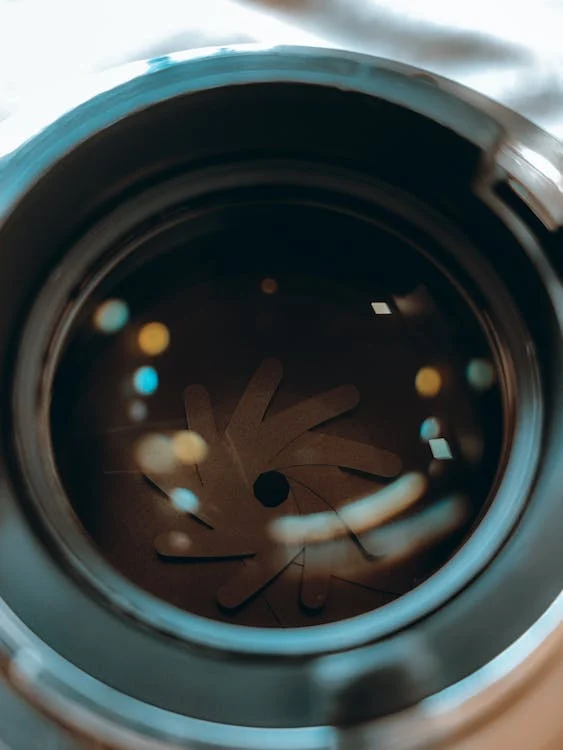
Types of filter lens protectors
Lens protectors, called ‘filters,’ protect your device lenses from damage. They provide sharper, more explicit photos with remarkable clarity. The types of lens protectors/ filters are listed below:
UV lens filters/protectors
An Ultraviolet filter known as the UV Filter is a piece of glass that prevents your camera’s sensor from being damaged by ultraviolet light. Using a UV filter serves two primary purposes:
- Remove haze from your images and videos to improve their sharpness.
- Prevent dust, tiny scratches, and other hazards from getting on your lens regularly.
With a UV filter, your exposure settings are unaffected. You may leave it on your lens all the time and be confident that the front is well-protected since it enables 99.99 percent of light to pass through. Outdoor photography is full of hazards, but if you’ve got an appropriate lens filter on it, it may save your camera. Having dust on your lens increases the danger of a scratch caused by the accumulation of dust.
Provides Anti-Fingerprint Security
Using a UV filter will keep fingerprints and other scratches off your front element. Lens coatings might be damaged over time by the acid in your fingerprint. Both fingerprints and stains may decrease the contrast of the lens.
Because of their size and flat surface, UV filters are far more likely to accumulate fingerprints than the lens’s front element. As a result, you’ll have to clean the filter considerably more often than the lens.
When choosing a UV filter, it is vital to go for a standard one. In a cheap one, ghosting, flare, and loss of contrast are the most common problems you’ll see due to using these cheap filters. Also, it impacts the clarity of the image.
waka 72mm MC UV Filter
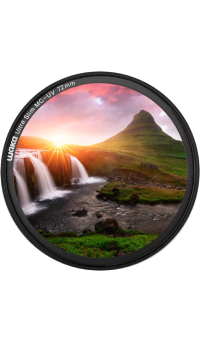
Using the Osaka 58mm UV Filter for the Canon EOS DSLR camera, you can eliminate undesirable light effects and preserve your lens. The 58 mm filter thread on all of your lenses means you can use this filter. This reduces flare and ghosting, shielding the picture from UV rays by using mc filters. Also, it protects your camera’s lens from dust and scratches. Compatible with all 58 mm filter thread lenses on the market. The double threading on these filters makes it possible to layer many filters of the same size on top of each other.
- Cameras with 18-55mm lenses may utilize the filter.
- It shields the picture from UV radiation, creating a blue cast and altering the color cast.
- The UV filter aids in reducing distance haze and eradicating blurriness.
- It shields the lens of the camera from damage caused by dust and scratches.
- The filter’s glass is crystal transparent; therefore, it does not affect the picture.
- It’s simple to attach to the camera’s lens.
- You may fit a lens hood to it as well.
- Outdoor photography benefits from the reduction of haze generated by airborne dust particles.
Tiffen 55UVP 55mm UV protection Filter for Canon and Sony DSLR
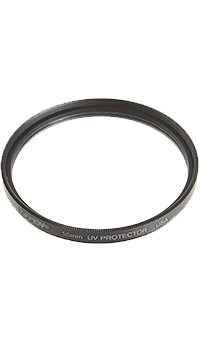
Tiffen 55UVP 55mm UV protection Filter is a transparent, all-purpose filter that reduces the daylight’s blue hue by absorbing ultraviolet radiation. If you’re taking photos at a high altitude or near a waterbody, this filter may help. This is because it doesn’t provide any extra contrast or hue and can be used with other filters.
Leaving the UV filter on your lenses all the time might provide additional protection from the sun’s harmful rays. Filters help keep dust and moisture out of your lens element and provide an extra layer of defense against damage from drops or other hazards.
As part of the Color Core process, Tiffen 55UVP 55mm UV protection filters are created by fusing two pieces of optical glass, laminating the filter substrate between them, and then grinding them flat to within a 1/10,000th of an inch of accuracy.
- Reduces the blue hue of sunshine by absorbing some UV radiation.
- You may use the clear filter with other filters because it doesn’t provide any more color or contrast.
- The general protection filter protects the lens elements from damage, which keeps out dust, moisture, and scratches.
Skylight filter
In the early days of color film, particularly transparency film, there was a particular issue with a blue cast that might detract from overall color in specific situations. The ‘skylight’ filter gets its name from the presence of cool bluish light, which may be seen in the skies and clouds and the shadows of snowy landscapes.
The skylight filter is a very mild magenta color filter, with 1A filters being lighter in hue than 1B filters. As a result, images with frigid tones are made warmer. As an added plus, it shields the front of the lens if it gets burnt or scratched. It is far easier and less expensive to change a filter than to repair a broken lens.
TIFFEN 72MM 1A skylight filter
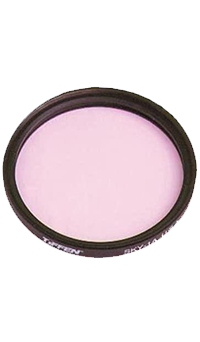
In Tiffen filters, the unique Color Core technique is used. This involves laminating the filter material between two pieces of optical glass. First, it is ground flat to tolerances of a one-tenth inch and then mounted in precise metal rings. Tiffen’s Color Core method controls the color and density with higher precision control. Color and density stay unchanged when Tiffen filters are ground and polished.
- Protects your camera or camcorder’s lens against dust, moisture, fingerprints, scratches, and other damage caused by the elements.
- At all times, you may keep this app on your camera.
- Absorbs over 50% of all ultraviolet rays
- Filter widely used by the general public.
- Enhances color and warmth with pink-tinted hues
- Assists in shooting in open shade and on cloudy days.
Lens hood
The benefit of using a lens hood is that it protects your lens from damage. A lens hood adds an extra layer of protection to your camera’s lens against damage from things like rain, snow, dust, and other flying debris. Many photographers opt for a UV filter or even a lens cap to do this. A lens hood is a must-have when photographing outside in inclement weather if you don’t want the elements to damage your lens.
Furthermore, the front of the lens is shaded, preventing flares and a washed-out appearance caused by light falling across the lens. A lens hood may help you get a crisp image without glare by shielding the camera from light. A lens hood is a must-have accessory for anybody taking professional photos, such as headshots or school photographs.
Usage methods
- Using camera lens hoods is a simple process that everyone can do. It’s easy to attach the lens hood to the front of your camera by screwing it on.
- Hood lenses may also take up a lot of space while you’re on the go with your equipment. The hood on your lens may be reversed to lessen the amount of space it takes when stored.
The Type of hoods
Lens hoods come in a variety of forms, but the most common are petal and cylindrical.
The Petals shaped Lens Hoods
For wide-angle lenses and full-frame cameras, Petal Lens Hoods are intended to be shorter. They feature curved notches that block off the light while expanding the frame size.
There is a slight risk that the hood will show up in your shot as the field of vision becomes narrower with longer focal lengths.
Cylindrical-shaped lens hood
Cylindrical lens hoods shield your lens from stray light and safeguard it from damage. You can spin the Petal lens hood so as not to get the shade of the lens in the picture.
Canon EW-63C Lens hood
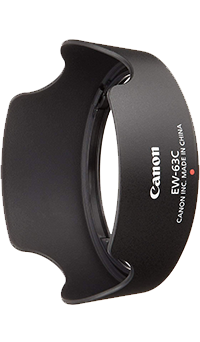
Canon’s EW-63C Lens Hood provides a shield from unwanted light, reduces glare, and protects it from physical damage.
Altura Photo Lens Hood for Canon EF 85mm
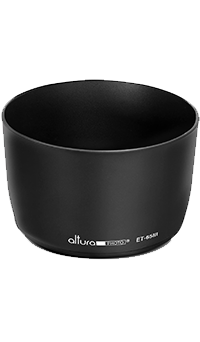
Altura photo lens hood was created to go with a specific lens using a particular focal length in mind. Designed mainly for Canon lenses, the ET-65III is an ideal replacement for the original model lens hood.
The use of lens hoods may assist reduce the appearance of flares (circles of light) in photographs taken close to light sources. Additional benefits include the protection of lenses and filters from unintentional damage such as knocks and scratches. When it comes to photographs, they are one of the most critical (but ignored) accessories.
- The bayonet locking mechanism is entirely secure.
- A perfect fit is guaranteed with this model’s ergonomic design. There is no wiggle or cross-threading here.
- Improves picture quality by reducing light pollution.
- It’s made of high-impact plastic, so it’s really sturdy while still being incredibly light.
- The hood’s reversible construction makes it simple to store in a backpack.
- Lenses used with Altrua lenses include Canon’s EOS-D EOS -1Ds Mark II, Canon’s EOS-1Ds Mark III, and the EOS-1Ds Mark IV.
When to go for a Lens Hood?
You can use a lens hood in most situations; however, they are particularly beneficial in the following conditions:
- When there is a bright light.
- When the sun is low in the sky, you’re photographing near strong light sources.
- In the vicinity of traffic lights, streetlights, and building and automobile headlights.
- For long-duration photographic sessions and places where your camera is exposed to damage.
Lens Cap
Protecting camera lenses while they are not in use is essential. Lens coverings are much more cost-effective than purchasing a new lens if you damage it. Lens caps are designed to guard against damage to the lens. Lens caps come in two varieties: front and back.
Front lens cap
- Snap-On Lens
Inside the camera’s lens, a snap-on is joined to the camera’s lens ring. For photographers who use lenses that accept filters, this kind of cap is ideal. The lens cap and filters should be the same size. If you look at the camera lens’s side, front, or rim, you may determine the camera’s dimensions. Snap-on lenses come in the following standard sizes:
Many lens caps are available, including 27 mm, 28 mm, 30 mm, 34 mm, 37 mm, 39 mm, 40.5 mm, 43 mm, 46 mm, 49 mm, and 52 mm.
- Lens Caps with a Push-On Mechanism
Push-on caps are the most common of the kind, and they fit over the camera lens. Snap-on caps are more frequent, but they’re less effective. This option may be the only one available to you if the camera lens does not contain filter threads. You will need to use a metric ruler to determine the correct size of the lens. There is a hat sizing guide here
- In-house Caps
The lens maker creates these caps for a specific lens and is not interchangeable and protects your lens.
Rear lens cap
To put it simply, rear lens covers are for cameras with a detachable lens attached. If the camera has an interchangeable lens, the rear lens cap is necessary. Look at the camera and determine whether this hat is necessary for you before purchasing it. There are three options to pick from if one is required.
- Bubble level
It is joined to the lens by twisting and securing the bayonet attachment of the camera lens.
- Screw on
Lenses with a threaded mount use these kinds of lens caps.
- Push on
Lenses that slip over the camera’s mount are the most prevalent.

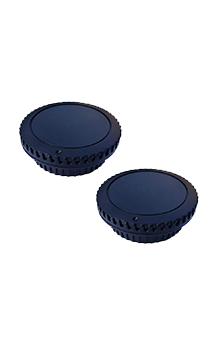
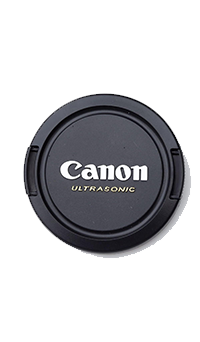
Tips for Keeping Your Camera’s Lens protected
- Lenses will be shielded from the elements such as dust and fingerprint by the filter. If your camera is dropped on a hard surface, your lenses will also be covered. You may shield your lenses from weather-related components by using protective filters.
- Keep a wet towel in your camera bag at all times to clean up any spills and while changing your lens. This will come in when you need to swap out your lenses. Make sure the lens is clean before removing and reinstalling it by wiping it with a towel.
- A lens care kit is a must in wiping the surface with a moist towel. A paintbrush-like two-sided brush is included in the set. The brush has a foam eraser on one end that you may use to clean your lenses.
- Don’t use generic cleansers, as they may damage your filters and lenses.
- Protect your lenses from fungus and other hazardous factors in a humid, wet or stale environment. Dust, moisture, and lack of light all contribute to the growth of lens fungus. A temperature-controlled digital cabinet protects your cameras, lenses, and filters.
Methods to clean your Lens
- Gently remove the lens. Depending on the model or manufacturer, there may be a release button on your camera that you may utilize for this purpose.
- Use your blower (in the lens care kit) to remove all the dust and grime from the lens.
- Apply lens fluid with a cleaning tissue.
- Using a soft cloth, gently clean the lenses. It would help if you aimed toward the middle of the lens.
- Slowly reattach the lens one by one. Remove the lens cap if you are not using the camera or lens after the cleaning process.
Lens cleaner kit
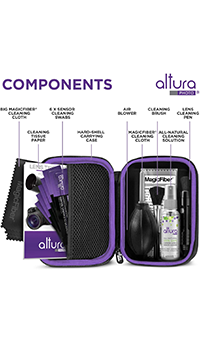
Lens cleaner kit removes specks and particles that are undetectable to the naked eye. APS-C sensors are supported. They don’t leave any stains or marks when cleaned and are safe to use.
This Kit comes with Lens Cleaning Pen + Lens Brush + Air Blower + 50 Sheet Tissue Lens Paper + 1 Large and Original MagicFiber Microfiber camera lens cleaning cloth are all included in the kit. It also comes with 6 Altura Photo 16mm Dry Sensor Swabs + Altura Photo All-Natural 2oz liquid cleaner.
Final Thoughts
It is essential to take good care of your camera lenses to improve their value and longevity. As a result, you’ll be able to produce high-quality images that communicate the tales you wish to share with the world.

